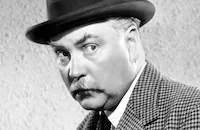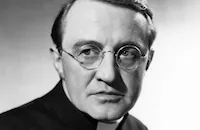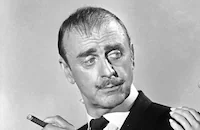The Corn Is Green

Brief Synopsis
Cast & Crew
Irving Rapper
Bette Davis
Nigel Bruce
Rhys Williams
Rosalind Ivan
Mildred Dunnock
Film Details
Technical Specs

Synopsis
In 1895, the inhabitants of Glansarno, a small village in the Welsh countryside, are taken aback when they learn that L. C. Moffat, their newest neighbor, is a forty-year-old English woman named Lily Cristobel, not a man as her Master of Arts degree had led them to expect. The other members of Moffat's household are her housekeeper, Mrs. Watty, a reformed thief, and Mrs. Watty's daughter Bessie. Despite the opposition of the village squire, Moffat intends to establish a school for the children who work in the nearby coal mines and drafts Miss Ronberry, a middle-aged woman, and Mr. Jones, a minister, to help her. She encounters stiff opposition to her plans, first from the mine owners, including the Squire, who refuse to release the boys from their long hours in the mines, and then from the owner of the barn she had planned to use for a schoolhouse. Discouraged, Moffat is about to give up her plans, when she reads an essay written by Morgan Evans, one of the boys, and is so moved by his rough poetry that she decides to hold classes in her house. Although many villagers attend the classes, Moffat focuses her efforts on Morgan. After a while, she believes that Morgan is smart enough to attend Oxford. Using flattery, she makes friends with the Squire and then asks him to vouch for Morgan to enable him to apply for a scholarship to the university. In the meantime, Morgan's friends make fun of his efforts to become educated. One day, feeling out of place, a drunken Morgan tells Moffat that he intends to return to the mines. She scolds him, but concedes that the decision to continue is his. Confused, Morgan leaves the house and outside, encounters Bessie. She flirts with him, taking his side against Moffat, and ends by seducing him. Morgan goes back to the mines, but eventually, decides to try for Oxford. Moffat coaches him steadily for the examination, but on the morning of the test, Bessie, who has been sent away into service, returns and tells Moffat that she is pregnant with Morgan's child. Moffat keeps this news a secret from Morgan. After the examination, Morgan tells Moffat how much he now wants to attend the university. While Morgan celebrates with Moffat, the Squire, Miss Ronberry, Mr. Jones and Mrs. Watty, Bessie arrives at the house. Mr. Jones spots her and, on a pretext, sends Morgan to the kitchen. Bessie then tells the assembled group about her pregnancy and Mr. Jones offers to marry her, but she laughs in his face, saying that she already has a man who will marry her, provided the child does not come with her. Mrs. Watty then persuades Moffat to adopt the child. When Morgan learns that he is to be a father, however, he insists on marrying Bessie, despite Moffat's attempts to dissuade him. After a telegram arrives, announcing that Morgan has won the scholarship, Moffat convinces him to attend the school and forbids him to see her again as she will be caring for his child. Morgan agrees to her terms and leaves her house for the last time to celebrate with the other villagers.

Director

Irving Rapper
Cast

Bette Davis

Nigel Bruce

Rhys Williams

Rosalind Ivan

Mildred Dunnock

Arthur Shields
Gwyneth Hughes
Billy Roy
Thomas Louden

John Dall

Joan Lorring
St. Luke's Choristers
Leslie Vincent
Robert Regent
Tony Ellis
Elliott Dare
Robert Cherry
Gene Ross
George Mathews
Jock Watt
Jack Owen

John Dehner
Sanders Clark
Joan Drake
Carol Ann Beekly
Nola Modine

Brandon Hurst
Herbert Evans
Billy Evans
David Hughes
Robert Cory
David Martin Jones
Rhoda Williams
Adeline De Walt Reynolds
Margaret Hoffman
Sarah Edwards
Faye Davis
Brad Towne
Gwilym Isaac

Leonard Mudie
Gene Michaels
Ronald Kay
Carl Huddleston
Bert Speiser
Stub Musselman
Crew
Gerald W. Alexander
Eddie Allen
Jane Bardwell
Clayton Brackett
Meta Carpenter
Frank Cavett
Dudley Chambers
Jack Chertok
Olga Collings
Bill Cooley
Joe Cramer
Paul Detlefsen
Parnell Eide
Leo F. Forbstein
Charles David Forrest
Hugo Friedhofer
Morris Goldman
Bob Hoffman
H. F. Koenekamp
Robert B. Lee
James Leicester
Herman Lissauer
Fred M. Maclean
Sam Mendelson
Fred Morgan
Harold Noyes
Charles O'bannon
Orry-kelly
Sol Polito
Frederick Richards
Maurice Riley
Casey Robinson
Marguerite Royce
Bert Shipman
Eric Stacey
Max Steiner
Robert Vreeland
Jack L. Warner
Robert G. Wayne
Perc Westmore
Carl Jules Weyl

Videos
Movie Clip



Trailer
Film Details
Technical Specs

Award Nominations
Best Supporting Actor
Best Supporting Actress
Articles
The Corn is Green (1945)
Ethel Barrymore played Miss Moffat to great acclaim onstage, but Hollywood didn't consider her a box-office attraction. So when Warner Brothers acquired the film rights to The Corn is Green, they gave the role to their biggest star, Bette Davis, although Miss Moffat was supposed to be in her fifties, and Davis was only 36. Davis, who never hesitated to look unglamorous if the role required it, wore a "fat suit" which made her look 30 pounds heavier, and an unflattering gray wig. That wig may have saved her life when a light fell above her, and a piece of it hit her on the head. The padded wig protected her, and she was unhurt.
With Davis headlining, the studio felt free to sign several lesser-known but talented members of the Broadway cast to repeat their roles on film, including Richard Waring, the young actor who had played Morgan Evans. But it was wartime, and Waring was drafted. Another theater actor, John Dall, replaced him. Among the actresses considered for the part of Bessie, the sluttish girl who seduces Morgan and threatens his future, were Angela Lansbury, Betty Field, and Warner Brothers contract player Andrea King. Bette Davis reviewed the tests, and favored the unknown Joan Lorring, who got the role.
Both Dall and Lorring were terrified of working with Davis, but both found her helpful and nurturing, even when she chastised Lorring for forgetting her lines. Unlike some stars, Davis habitually stood off-camera, in costume and in character, feeding lines to other actors when the director was shooting their close-ups. Dall and Lorring recalled that she did this for them, even coming in on her day off when Lorring's close-up was scheduled. "I have only had one or two teachers in my life about whom I felt as strongly and positively as I did about Bette Davis," Lorring would say later. Davis was "wonderful," Dall told a fan magazine. "Every time I played a scene with her, I felt strength coming to me from her." Dall and Lorring both received Academy Award nominations for their supporting performances in The Corn is Green.
Toward director Irving Rapper, however, Davis wasn't so benevolent. Rapper had been Davis' dialogue director on several of her films in the late 1930's, and she suggested to studio executives that Rapper might make a good director. Rapper had directed one of Davis' biggest hits, Now, Voyager (1942), but some observers thought that the reason Davis liked working with Rapper was that she could dominate him and have her own way on the productions. It certainly appeared that way on The Corn is Green, and the director finally snapped. As their arguments escalated, Rapper accused Davis of trying to do his job and Davis threatened to have him fired. Then, Rapper threatened to quit, and walked off the set. But not only did he return, he made two more films with Davis.
Although exterior sets were usually created on the back lot, that was not practical for The Corn is Green, which required both winter and fog effects. So the studio's art department built the Welsh village on a huge soundstage. It included roadways made of four hundred cubic yards of dirt-covered plywood, and twenty tons of grass sod which was fed, mowed and watered daily. A hundred goats had to be fed constantly, so they wouldn't eat the grass.
Reviews for The Corn is Green were excellent, particularly for Davis' performance, and for retaining the integrity of the original. E. Arnot Robinson wrote in Picture Post, "only Bette Davis...could have combated so successfully the obvious intention of the adaptors of the play to make frustrated sex the mainspring of the chief character's interest in the young miner," and praised her "subtle interpretation."
In spite of the good reviews, Bette Davis would later say that she wished she'd been more mature when she took on the Moffat role. In fact, she did get another crack at it, at the age of 66, in a 1974 stage musical, Miss Moffat. Emlyn Williams and director Joshua Logan moved the setting from Wales to the American South, and made Morgan Evans a black man. In spite of good reviews, the show folded before it made it to Broadway, with Davis and Logan each blaming the other for its failure. In 1979, George Cukor directed Katharine Hepburn in a well-received television version of The Corn is Green.
Director: Irving Rapper
Producer: Jack Chertok
Screenplay: Casey Robinson, Frank Cavett, based on the play by Emlyn Williams
Editor: Frederick Richards
Cinematography: Sol Polito
Costume Design: Orry-Kelly
Art Direction: Carl Jules Weyl
Music: Max Steiner
Principal Cast: Bette Davis (Miss Lilly Moffat), John Dall (Morgan Evans), Joan Lorring (Bessie Watty), Nigel Bruce (The Squire), Rhys Williams (Mr. Jones), Rosalind Ivan (Mrs. Watty), Mildred Dunnock (Miss Ronberry).
BW-114m. Closed captioning. Descriptive video.
by Margarita Landazuri

The Corn is Green (1945)
Quotes
That man is so stupid, it sits on him like a halo.- Miss Lilly Moffat
Trivia
Notes
Rhys Williams, Rosalind Ivan, Mildred Dunnock and Gene Moss, members of the Broadway cast of Emlyn Williams' play, reprised their roles for this film. Ethel Barrymore portrayed "Moffat" in the Broadway production. According to a July 30, 1944 New York Times news item, John Dall replaced Richard Warring when the latter was drafted. Hollywood Reporter news items add the following information about the production: Ida Lupino was to star in the film with Bette Davis. Warner Bros. paid $135,000 for the rights to the play and agreed not to release a filmed version until November 1943. Production reports included in the Warner Bros. Collection at the USC Cinema-Television Library note that the film was shot in continuity in 72 days. John Dall and Joan Lorring, who made their motion picture debuts in the film, were nominated for Academy Awards for Best Supporting Actor and Best Supporting Actress, respectively. Olivia De Havilland starred with Richard Basehart in a June 12, 1950 Lux Radio Theatre broadcast of the story. It was performed again on May 17, 1954. Williams' play was remade for television in 1979, starring Katharine Hepburn and directed by George Cukor.















